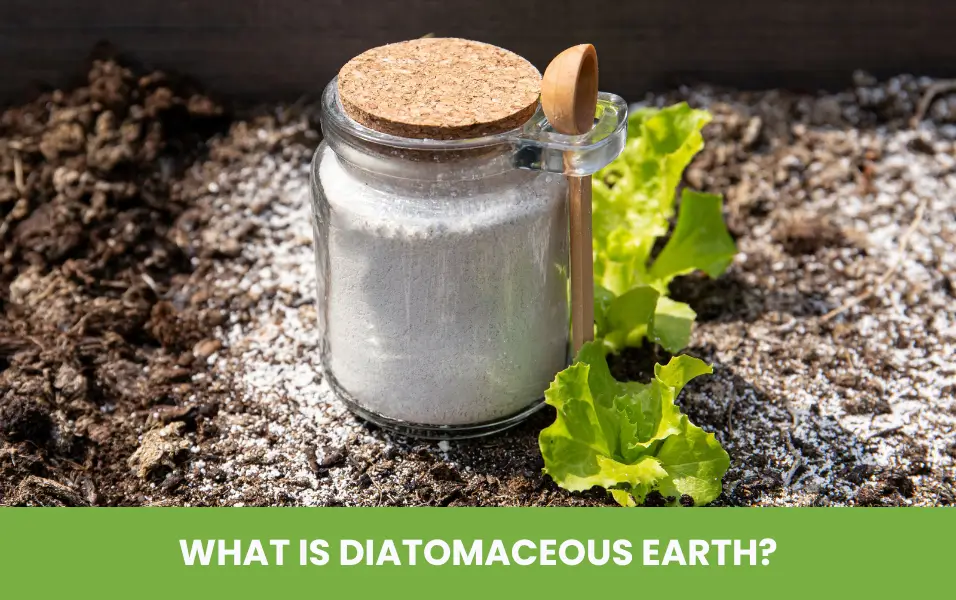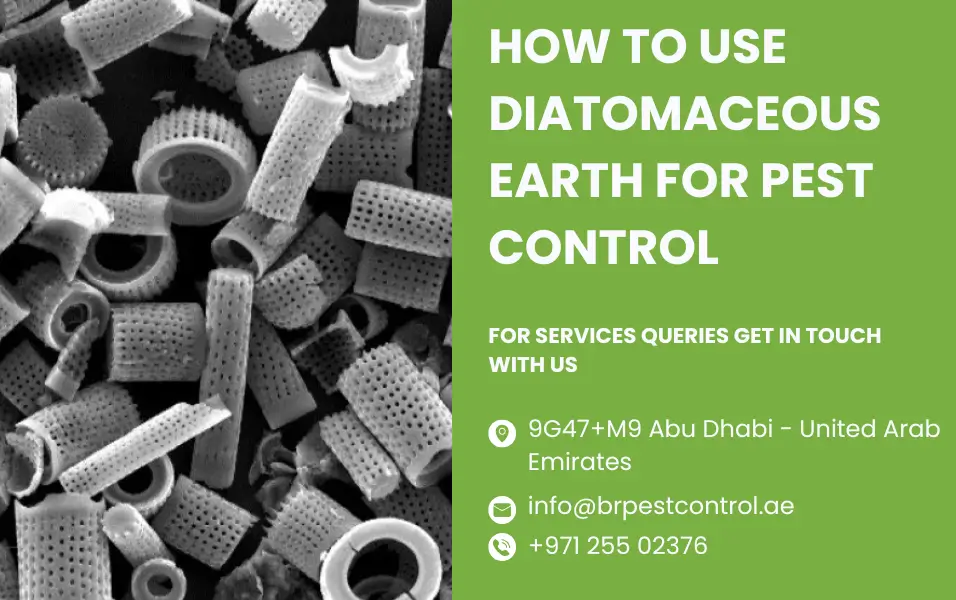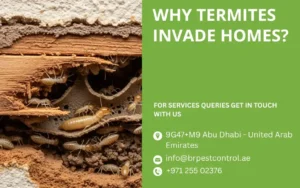How to use diatomaceous Earth for pest control? Diatomaceous earth is a natural pest control method that effectively repels insects from vegetables, herbs, and houseplants, providing long-term benefits to your garden.
DE, or deterrent, is an organic method to deter pests like ants, aphids, caterpillars, slugs, and snails without harmful chemicals. It’s applied to plants, creating a barrier that protects and enhances the environment.
Contents
- 1 || What is Diatomaceous Earth?
- 1.1 The Benefits of Using Diatomaceous Earth for Pest Control
- 1.2 Types of Pests Diatomaceous Earth Targets
- 1.3 How to Use Diatomaceous Earth for Pest Control
- 1.4 Safety Tips and Precautions When Using Diatomaceous Earth
- 1.5 How Long Does Diatomaceous Earth Take to Work?
- 1.6 || Our Services For Pest Control
- 1.7 Conclusion: Is Diatomaceous Earth the Right Choice for You?
- 1.8 FAQs: (Frequently Ask Questions)
|| What is Diatomaceous Earth?

Diatomaceous earth, or diatomite, is derived from fossilized remains of tiny, aquatic organisms known as diatoms. These organisms, with skeletons composed primarily of silica, accumulated over long periods in river, stream, lake, and ocean sediment, creating rich deposits that are now mined for various uses.
The silica within diatomaceous earth has unique properties. It forms a major portion of the earth’s crust and appears in forms like sand, quartz, mica, feldspar, emerald, clay, asbestos, and glass.
Silicon is a part of silica, but it doesn’t usually show up in nature in its pure form. Instead, it usually joins with oxygen and water to make silicon dioxide, which can be solid or amorphous. Amorphous silicon dioxide is common in diatomaceous earth.
As a pest control method, the rough edges of diatomaceous earth remove the oils and fats from an insect’s skin. It keeps them locked up and kills them without hurting the surroundings. To get rid of mites and other bugs that are bad for you, pesticides with silicon dioxide have been registered since 1960.
The Benefits of Using Diatomaceous Earth for Pest Control
Diatomaceous earth offers a natural, effective approach for creating a healthier, pest-free home. The fine powder comes from the ancient remains of diatoms, which are tiny watery creatures.
It has microscopic, sharp edges that eat away at pest exoskeletons, dehydrating and killing them. This works well to get rid of ants and cockroaches without using chemical poisons.
Diatomaceous earth is versatile beyond pest control. It can enhance indoor air quality by absorbing dust, pollen, and pet dander. With its natural deodorizing ability, it neutralizes odors from sources like garbage cans and shoes, leaving a fresher living space.
Because it absorbs water, it’s also great for damp places like bathrooms and basements to keep mold and mildew away.
This non-toxic cleaner is safe for kids and pets, and it gently scrubs surfaces like sinks and tubs. It’s also good for the environment, which encourages green living.
Types of Pests Diatomaceous Earth Targets
| Type of Pest | Examples | Effectiveness | Notes |
|---|
| InsectsAnts, cockroaches, bed bugs, fleas, earwigsHighDiatomaceous earth damages the exoskeleton, causing dehydration. |
| Spiders | Common house spiders, brown recluse, black widow | Moderate to High | Works well on smaller spiders, especially in dry conditions. |
| Beetles | Carpet beetles, grain beetles, stink bugs | High | Effective on a variety of beetle species, especially in dry areas. |
| Mites | Dust mites, bird mites | High | Useful for areas like bedding and furniture where mites reside. |
| Lice | Head lice, body lice | Moderate | Requires careful application; avoid breathing dust particles. |
| Centipedes & Millipedes | House centipedes, common millipedes | Moderate | Works on contact but may require reapplication in humid areas. |
| Slugs & Snails | Garden slugs, common snails | Moderate | Less effective in very damp conditions; ideal for dry areas. |
| Scorpions | Bark scorpions, Arizona scorpions | Moderate to Low | Works best around entry points to limit indoor infestations. |
| Other Crawling Insects | Silverfish, crickets, earwigs | High | Excellent for indoor use around cracks, crevices, and edges. |
Diatomaceous earth is highly effective for pest control. It targets a wide variety of pests with exoskeletons, including cockroaches, bed bugs, fleas, ticks, spiders, mites, lice, silverfish, ants, millipedes, centipedes, earwigs, crickets, flies, stink bugs, aphids, thrips, grubs, and some beetle species.
It works differently from chemical methods because the pests have to come into close contact with the powder for it to work. DE starts to soak up the oils from pests’ shells when used along floors. It causes the pests to dry out and die.
When there are many pests, especially in places where they like to live, more than one treatment may be needed. In places that get a lot of use, it is suggested that you refill every 24 hours.
To keep using your home normally while getting rid of bugs, put DE around the edges of rooms. For bigger areas, try closing off one area at a time and leaving DE they’re for part of the day. Then, clean up and reopen that area.
How to Use Diatomaceous Earth for Pest Control
Many people call diatomaceous earth (DE) “pesticide.” It works very well to get rid of roaches, fleas, ants, and other bugs that come into homes and businesses.
The glass-like silica that makes up the structure of tiny diatoms gives DE its sharp edges. When insects come into contact with these rough particles, the silica cuts through their skin, removing the protected shell most of the time.
This process not only damages the insect’s outer layer but also absorbs essential fat and oil from the exoskeleton, leading to the bug drying out and ultimately dying.
Safety Tips and Precautions When Using Diatomaceous Earth
Using diatomaceous earth for pest control can be highly effective, but safety should always be a priority. When applying food grade DE in your home, it’s important to remember that inhaling it is no more harmful than inhaling dust.
However, certain individuals, such as the elderly, those with asthma, smokers, or families with small children, may experience respiratory discomfort. Using breathing masks is recommended to make the experience safer.
| Tip | Precaution |
|---|
| Use Food-Grade Only | Choose food-grade diatomaceous earth for safety. |
| Wear Protective Gear | Use gloves, mask, and goggles to prevent irritation. |
| Avoid Inhalation | Apply in well-ventilated areas to avoid lung irritation. |
| Keep Away from Children & Pets | Store securely to prevent accidental ingestion or inhalation. |
| Apply Sparingly | Use a light dusting to minimize airborne particles. |
| Clean Up After UseSweep or vacuum excess DE once pests are controlled. |
Always use DE in places with good airflow. Having a good cross-flow of air can help keep airborne buildup to a minimum.
If you have any breathing problems, like coughing or shortness of breath, you should remove the DE right away with a wet towel or vacuum cleaner. If the pain doesn’t go away, you should see a doctor.
How Long Does Diatomaceous Earth Take to Work?
Different kinds of insects can be killed with diatomaceous earth, but it doesn’t work right away. The process can take anywhere from a few hours to a few days, based on the pest and the weather.
A bug may die as soon as 12 hours after going into the powder and having its skin pierced by the sharp edges, which causes it to lose water. Individual insects can be killed quickly.
For best control, the product should be applied again about once a week. After eggs hatch, nymphs and adults emerge, and all of them need to come into touch with diatomaceous earth for it to work.
The chemical-free option will work best if a small layer is put down correctly in places where bugs are known to go. Diatomaceous earth can keep working forever if it is used the right way.
|| Our Services For Pest Control
Conclusion: Is Diatomaceous Earth the Right Choice for You?
Diatomaceous earth is a natural, chemical-free option that works for many pest control needs. It’s ideal for those who want an eco-friendly solution, though patience is essential since it doesn’t work instantly.
Assess your lifestyle, the types of pests you face, and how often you’re able to reapply. For homes with pets or children, ensure safe, careful placement.
Compare diatomaceous earth with other methods based on effectiveness, cost, and ease of use. If you need immediate results or have severe infestations, professional treatments might be better suited to your needs.
FAQs: (Frequently Ask Questions)
How does diatomaceous earth kill pests?
Diatomaceous earth kills pests by using sharp, microscopic edges that cut through an insect’s exoskeleton, causing it to dehydrate and die.
Is diatomaceous earth safe to use around pets and children?
Food-grade diatomaceous earth is safe for kids and pets as long as it is used properly. Do not breathe them in, and do not put them in places with a lot of foot activity.
How long does it take for diatomaceous earth to work?
It can take anywhere from a few hours to a few days for diatomaceous earth to kill pests, based on the type of pest and its surroundings.
Where can I apply diatomaceous earth in my home?
It can use to get rid of bugs that like to hide along walls, under furniture, around windows and doors, and other places.
Do I need to reapply diatomaceous earth regularly?
To keep the shield against pests strong, you should add diatomaceous earth every week or after cleaning.





